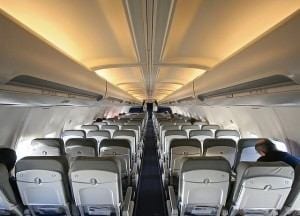
When you get on your next flight you might be wondering, is it me or are airline seats getting smaller?
It’s not you. More and more airlines are reducing the width of their seats. Coach seats on many airlines are shrinking to 17 inches wide. At this time, the average seat width for a first-class seat on a Boeing 777 is 21 inches.
Now compare that 17-inch seat size to other seats. A stadium seat is 19 inches wide, and Amtrak coach seat is 20.5 inches wide and a movie theater seat is a roomy 25 inches wide.
In what could be seen as a dig on its rival Boeing, Airbus commissioned an independent research study that has recommended that airplanes provide 18-inch-wide seats for long-haul flights. The report found that passenger sleep quality improved by 53 percent when they slept in 18-inch-wide seats instead of slimmer seats.
It’s not just sleep quality, it’s physical comfort. One engineer noted that at least 20 percent of the population is wider than the standard seat design.
Despite passenger comforts, delivering a plane with 17-inch seats allows for extra seat per row, which translates into added revenue. MSNBC reports that adding just 6 seats to an economy cabin that had held 140 can raise revenue by up to 4 percent.
Airlines are adding these seats to get more passengers per flight and to reduce the costs of fuel. Here’s where you’ll feel the pinch:
- Southwest has added 6 seats per flight to Boeing 737s, resulting in one or two inch less of seat pitch
- US Airways have added four seats on its Airbus 321
- United has added six seats to its Airbus A319s and A320s
- Alaska has added six to nine seats to its Boeing 737-800s and 737-900s, respectively. But there will now be power outlets for each seat.
Another airline changing their seat is JetBlue, but they aren’t adding any rows. They’re replacing their seats altogether on Airbus A320s. The old seats are being replaced by lighter ones with less cushion to lighten the weight of the plane. Delta will also be using slimmer seats, which may add an additional row on some of their aircraft. Southwest, which is also opting for lighter seats, expect the change to save $10 million in fuel costs.
Don’t worry, the airlines are trying to argue these smaller seats will give people more room even though their personal space has shrunk. Other airlines say passengers won’t even notice the change. They say keeping you distracted with in flight television and snacks will keep your mind off the smaller, more cramped, sleep-depriving seats.
When it comes to inflight entertainment, even though gadget can now stay on. It’s harder to keep them charged. Routehappy reported that for only 5.2 percent of flights on U.S. carriers–Delta, American, United, Hawaiian, Virgin America, US Airways–are on aircraft with USB or AC power.
What do you think? Would you trade a smaller seat for better entertainment and snack options?
For more of your airline seat options, check out:
- 5 North American Airlines with the Most Comfortable Coach Seats
- How to Pick Seats on a Plane
- How to Book the Best Coach Seats without Paying Extra
- Airlines Reduce Legroom Even More
By Judith Retana for PeterGreenberg.com












